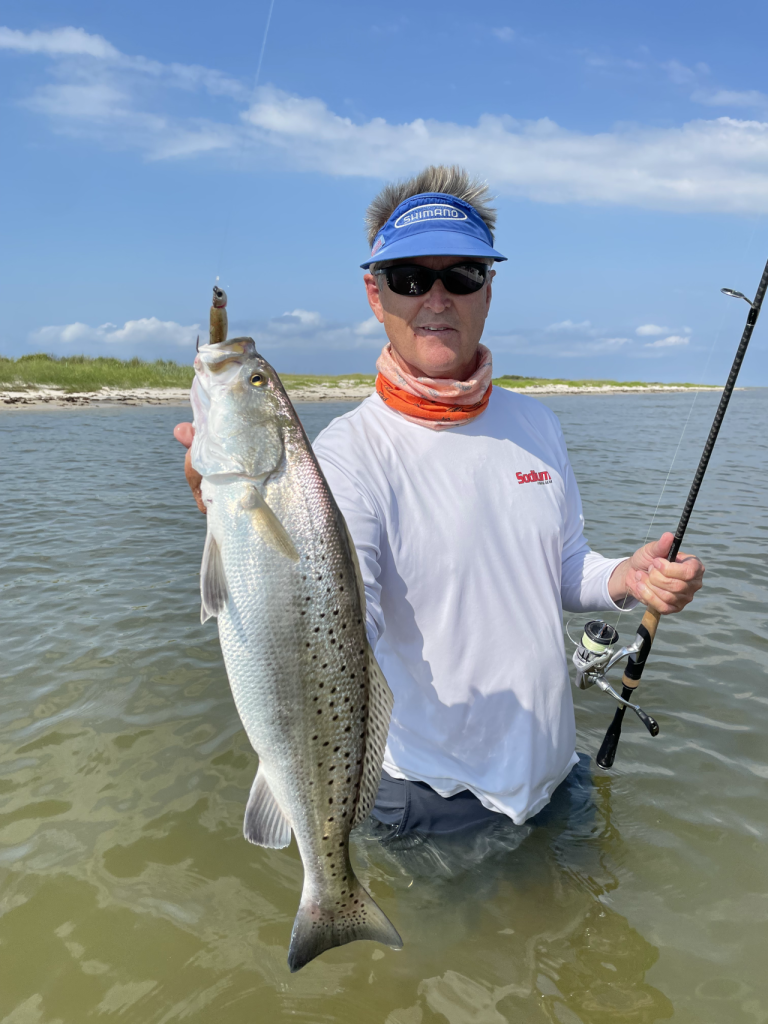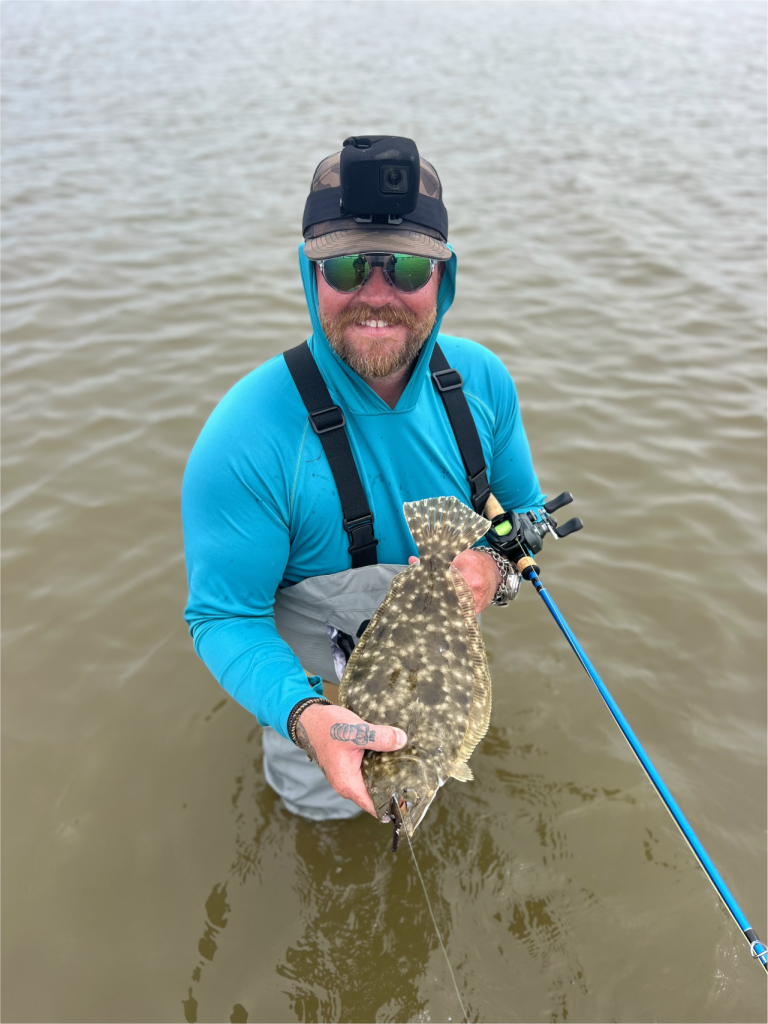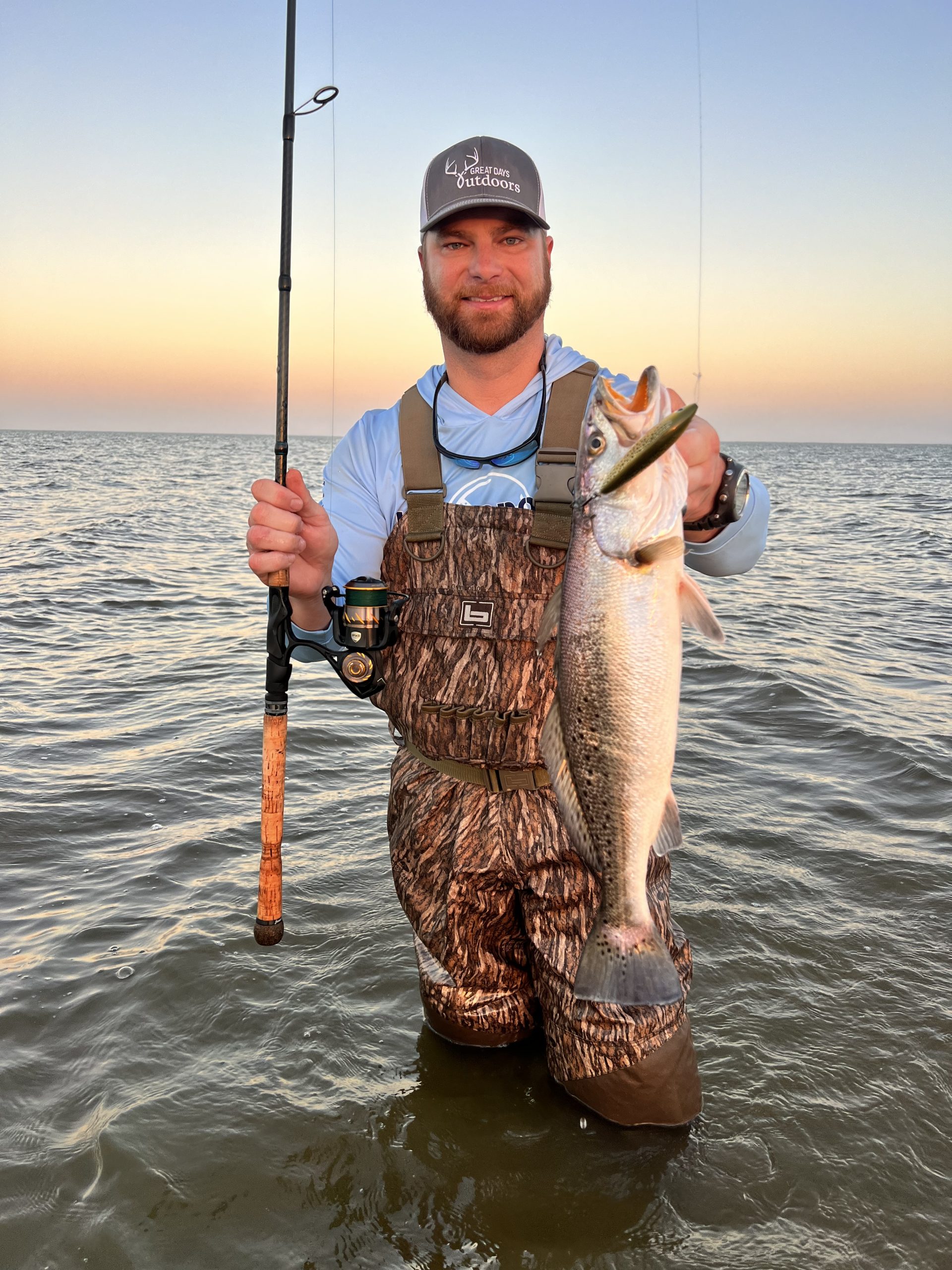I consider myself a novice when it comes to inshore fishing. I grew up primarily offshore fishing but since I have started hosting the Alabama Saltwater Fishing Report podcast I have grown to love the inshore game. One of my favorite ways to target inshore species is by wade fishing. There is nothing like getting in the water with these fish and watching a topwater blow up at sunrise is an experience like no other. We talked with Capt. Richard Rutland on a podcast recently to get all of the nitty-gritty details that have made him a successful wade fisherman. I do not know about you, but when I get a chance to chat with someone who does this kind of fishing for a living, I pay close attention to the where, how, and why. Most of what we are talking about in this article relates to many different places all along the Northern Gulf Coast.
What Is Wade Fishing?
Wade fishing is a method of fishing that can be very effective for many reasons. Wade fishing away from the boat allows you to be stealthy and a bit sneaky approaching fish or fishy spots. A boat in the water makes a lot of noise and causes water displacement that the fish can feel, especially on calmer days. When wade fishing you want to park your boat at a minimum of 100 plus yards away from your fishing spot. Make sure you use a good heavy anchor and anchor the boat off the beach a little. It takes no time for the waves or a wind change to blow the boat up on the beach, which leads to calling a buddy to pull you off, not to mention if you have a storm blow up on you quickly.
What Are The Benefits Of Wade Fishing?
The benefits of wade fishing are summed up in two words: Sneak attack. The boat makes a lot of noise. Of course, you have hull slap, the waves slapping on your hull making noise and you have whatever walking around and beating and banging noise you are doing on the boat. As you are either drifting in or on your trolling motor (Which also makes noise) The biggest thing Capt. Richard thinks about is the displacement of the hull. “As you are moving along, the boat is pushing water in front of you and as you move through the water sucks in behind you, and the fish can feel a much bigger creature in their area. So when you jump in the water and wade, I would not say they totally do not know you are there, but they totally do not know you are there. I know this is true because I have fished flats over and over again from my boat, day after day, and caught a handful of fish. Then go wade that exact spot and it is night and day difference, you can really up your numbers by getting in the water with the fish.”
Wade Fishing Spots
When we asked Capt. Richard what he looks for in a wade fishing spot, this is what he had to say. “Recently, I have opened up a lot of doors when I opened my mind a little bit by looking at places through a wade fishing lens. When I start thinking about wade fishing a new spot, I think about places that I have previously had some success from my boat, typically when the water is high. The things that I look for when I am looking for a spot to wade, number one would have to be bait, second behind that will be the bottom type. Meaning grass or oyster shells, you have to have a decent bottom type, you do not want to be sinking in the mud trying to fish, you will be falling all around. When I am looking to wade a spot in a marshy area, I am looking for shells on the bottom preferably, also I look for a creek or some sort of flowing water. The other thing I look for is bottom relief, a real nice area where there are troughs and bars and different water levels. These gamefish are ambush feeders so sit down in these troughs and holes, hiding and water for bait to be washed over their heads to ambush their meal.”
“Most years when approaching late spring and early summer I jump at the opportunity to get on the beaches well before the fish show up. I like to run at a slower speed and really take note of the “lay of the land” and make marks on my GPS to come back later and fish in the future.

Utilizing your GPS does a couple of things for you. I like to start my morning very early and finding a place I am not familiar with in the dark can have its challenges and that recorded information makes things easier. It also provides me with several location options to fish if other fishermen are in any of the places I marked. Anytime you can find structure on the beach like wrecks, rocks, bulkheads, pilings and clay/mud lumps are great places to start as well. The main ingredient for me though is always finding big schools of mullet. It doesn’t have to be finger mullet sized bait either, I like to see schools of big mullet either jumping or smoking on the surface. When I think about how to catch speckled trout in the surf, I always prefer to be in the water if possible but sometimes that can be tricky due to the sea state.”
Setting Up A Wade
This is what Capt. Richard had to say about how he sets up the ideal wade. “Generally when I go to set up a wade, the number one thing that I am going to do is set myself up to fish well. Meaning I want the wind at my back and be able to make bomb casts to get the bait as far away from me as possible. I am going to set my boat up where I can slip out of the boat and walk 100 yards and then start fishing with the wind at my back. Being able to cast as far as possible is very important. If you are fishing with your buddy and he may not be able to cast as far as you. If you add up the number of feet you cast and then the number of feet that another angler casts, if you cast 10 feet further over 500 casts on that day, that is almost an extra mile of water being covered at the end of the day!”
Wade Fishing For Speckled Trout
We asked Capt. Richard, “What do you do differently to target Speckled Trout specifically while wade fishing?” “I almost always throw plastic when I can, that is what I love to do so that is what I am doing 90% of the time. I generally carry two rods. I am typically going to start out with topwater. If I am throwing topwater and I make some good casts and good presentations and I am not getting bites and I know fish are there, then I am going to go to the Slick Lure”
Wade Fishing For Redfish
“Capt. Richard, What do you do differently to target Redfish specifically while wade fishing?”
“A redfish will almost always react to a topwater presentation, those fish are usually in 2 feet or so or less of water, and they cannot resist that thing twitching around up there.”
Wade Fishing For Flounder
“What do you do differently to target flounder specifically while wade fishing?

“For flounder, you are going to have to have a suspending bait like the Slick Lure or a jig head on the bottom, I will slow down my presentation a lot, when I see a hole or a spot that looks like it would be a flounder in there, I cast in there and will slow my presentation down, twitching it a lot slower and keeping it down on flounder level. I have even gotten to where I will keep a jig head or two with an artificial bait for flounder in my wade tackle box. Locating flounder I will look for some shell on the bottom or grass banks. I am looking for deeper water against shell or grass, they love steep drop offs because they are ambush predators.”
Wade Fishing With Live Bait
Capt. Richard had this to say about live bait fishing while wading. “When I think about how to catch speckled trout in the surf with live bait, I really favor croakers. They are usually very easy to come by at a few bait shops, pulling a small shrimp net, catching them on hook and line or cast netting them. Live Menhaden are very hard to keep alive but also work very well in the surf. For fishing live croakers, I like to use a 7 ½ foot medium power fast to moderate fast action rod and we fish a free-lined setup with no weight. I prefer a casting rod with 12 lb. monofilament line with a 4-6-foot section of 15-20lb. fluorocarbon leader with a 1/0 to 2/0 Owner SSW live bait hook. I like the casting rig because I can easily free spool the reel and let some line out to allow the fish to swallow the bait. When I get a bite, I usually count four to six seconds before setting the hook. We also use spinning setups with 7 ½ foot rods spooled with 15-20 lb. braided line with a four-foot section of fluorocarbon leader attached with an improved albright knot. To fish this saltwater wade fishing gear, I make long casts into or around the deeper sides of sandbars. I leave enough slack “belly” in my line to give the fish a chance to swallow the bait before I set the hook but, at the same time, keep enough tension on the line so I can slowly work the retrieve back and know when I get a bite. A typical cast and retrieve is about a one to three-minute process.
Sometimes, the whole bait will pull out of the fish’s mouth and, if you can be patient enough and pause, most times you will get another bite quickly. While I don’t know if these bites are from the same fish or other fish competitively feeding in the school, it frequently happens.
In terms of wade fishing baiting, I have found that hooking the bait through the top lip/nose of the croaker is the best route. There is a fine line between not hooking it deep enough or hooking it too deep and that will come with experience over time. It is important to note that if you aren’t getting bites relatively quickly you need to be moving. The beach bite is not really one to turn on and off at certain times. If they are chewing you will know it pretty quickly so always be on the move until you get a bite.”
Wade Fishing With Artificial Bait
Capt. Richard says this about wade fishing with artificial baits. “I prefer to fish lures when catching speckled trout in the surf due to the amount of water that can be covered in a short amount of time. Sometimes they are only on the live bait and not lures and other times you can catch them better on lures. If I am not getting bites, I am constantly moving down the beach to find the next school of fish.”
“My morning saltwater wade fishing gear is always a topwater lure, to start. If you get lucky and have very calm, quiet, and smooth conditions I prefer a smaller topwater like the Rapala Skitter-V. When I have a little more wave action and wind, I throw larger topwaters like my favorite, the Heddon Super Spook.
When it comes to color, pink always seems to be a great color but a lot of days I throw color out the window because it seems like it doesn’t matter. I like to try and match the color to the water conditions. If it’s a clear day with clean water I go with bright colors and if it’s cloudy or off-color water I go a little darker. Topwater is usually an early morning and low light tactic but I have seen many days when they will chew them up all day. You have to throw it to know what the fish are in the mood for that day. My all-time favorite piece of saltwater wade fishing gear and just favorite lure to throw for speckled trout anytime of the year is The Slick Lure. I like this soft plastic jerk bait because of the unbelievable natural action it has in the water and the translucent colors that they carry. I only fish this lure on the Owner Beast 4/0 in the 1/8 ounce weighted hook. The 4/0 hook only comes two ways which is unweighted and weighted 1/8 ounce. I only fish the weighted version year-round. My favorite colors are pink/chartreuse, pearl/chartreuse, goblin, bayou blues, cool beans, and mad mullet. While I primarily like to use Fishbites for redfish and flounder I have found that they also work well for speckled trout. In the Fight Club series, I’ve found that the Brawler five-inch jerkbait in the haymaker color is a winner. I also have had success with the four-inch Butt Kicker paddle tail also in the haymaker color. These are great for those occasions where you may be battling some dirty water conditions. The Haymaker color is a good dirty water color but also the added scent will also help to overcome tough water conditions. One of my other go to colors in the Counter Punch which is a Chartreuse color.

As far as rigging goes, I use from a 1/8 to ¼ ounce jig with a Hogie jig head for either the Brawler or the Butt Kicker and work it a little bit fast on the beach twitching it along pretty quickly. I also like rigging it with a weighted Fight Club weighted swim bait hook for a more subtle approach in calm conditions. I will put those on a 20-pound fluorocarbon leader attached to 15 to 30 pound braid and sometimes a lighter leader in clear water conditions.
You could tie them under a popping cork if you were fishing in dirtier water and for that setup, I use a 2 ½ foot section of leader under the cork attached to a Fight Club weedless hook worked with a 7 ½ foot medium light rod with an extra fast tip and a 2,500-3,000-size spinning reel. This is a great all around go to setup in many different conditions and areas around bays and estuaries.
As far as surf fishing goes for me I do not have a lot of opportunities to sight-cast Trout on the beaches but many times redfish make themselves available. The Fight Club series in many different patterns and colors are a great bait selection to take advantage of Redfish on the beach. I like to use the lightest weight that the conditions will allow to avoid making a big slash with the lure and spooking the fish. When casting I like to lead the fish or school of fish by quite a margin and reel the lure back quickly to get in front of the fish. Once you feel your lure is in front of the fish, slow down your retrieve with small twitches to spark a bite.”
Final Thoughts On Wade Fishing
The tactics outlined in this article can maximize your success while wading the coastal flats and marshes. Whether it’s targeting gator trout in shallow grass beds, stalking redfish in sandy potholes, or enticing flounder from shell beds or banks, the versatility of wade fishing allows anglers a variety of productive habitats. Remember, success in wade fishing often depends on finding the right spot and being able to set up on those fish in the sneakiest way possible. Take the time to study the water, read the signs of feeding activity, and adjust your presentation accordingly. Utilize a variety of artificial lures and live baits to entice strikes from wary fish, and don’t be afraid to experiment with different techniques and retrieves until you find what works best. So, whether you’re a seasoned wade fishing veteran or just dipping your toes into this exciting style of fishing, I hope Capt. Richard’s wisdom shared in this article will help you elevate your wade fishing game and make unforgettable memories on the water chasing trout, redfish, and flounder.
Full Disclosure: This post may include affiliate links. There’s no extra charge to our readers for using these.




